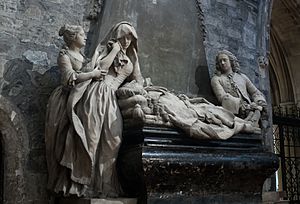Henry Cheere facts for kids
Sir Henry Cheere (born 1703, died 1781) was a famous English sculptor. He also worked as a "monumental mason." This means he created large stone carvings, often for memorials. His older brother, John Cheere, was also a sculptor.
Contents
Personal Life and Career
Early Life and Training
Henry Cheere was born in Clapham, Surrey. This area is now part of London. His parents were Sarah and John Cheere. When he was about 15, Henry started training. He became an apprentice to Robert Hartshorne in 1718. Hartshorne was a mason-sculptor.
Setting Up His Workshop
By 1726, Henry Cheere had his own workshop. It was located near St Margaret's, Westminster. A sculptor from Flanders, Henry Scheemakers, joined him for a few years. Cheere also took on many apprentices. These were young people learning the craft.
Important Roles and Travel
In 1743, Cheere became the "Carver" for Westminster Abbey. This was a very important job. It meant he created at least nine monuments inside the Abbey. He also bought land nearby. He took on many public roles. For example, he was a director for the Westminster Fire Office. He also became a Justice of the Peace around 1750. This meant he helped keep law and order.
In 1748, Cheere traveled to Paris. He went with other artist friends. These included famous painters like William Hogarth and Thomas Hudson. They also visited Flanders and the Netherlands.
Recognition and Retirement
In 1750, he became a member of the Society of Antiquaries of London. This group studies history and old things. He was made a knight in 1760. This meant he could use "Sir" before his name. In 1766, he became a baronet. This is a special title that can be passed down in a family. Cheere was part of a group that tried to start an English art academy. This happened before the Royal Academy was created.
He stopped working and sold his workshop items in 1770.
Death and Legacy
When Sir Henry Cheere died, his son William Cheere became the 2nd Baronet. However, William died in 1808 without marrying. Sir Henry also had two daughters.
Experts say Henry Cheere was a very skilled English sculptor. He was one of the first to be as good as sculptors from other countries. He often used small, detailed, and curved shapes in his work. Many of his pieces are not signed. One of his most famous works is thought to be in Shadoxhurst, Kent.
Works

- Monument to Robert Bertie, 1st Duke of Ancaster and Kesteven (around 1728; Edenham, Lincolnshire)
- Statue of Queen Caroline for The Queen's College, Oxford
- Statue of Christopher Codrington for All Souls College, Oxford
- Memorial to Capt Philip de Sausmarez in Westminster Abbey (around 1747)
- Monument to Admiral Sir Thomas Hardy (1666–1732) in Westminster Abbey
- Small statue of the Duke of Cumberland (around 1746 - 1770) – now in the National Army Museum
- Bust (head and shoulders sculpture) of Nicholas Hawksmoor – now in the National Portrait Gallery
- Monument to the Earl of Kildare in Christ Church Cathedral, Dublin
- Equestrian monument (statue on horseback) to King William III (around 1757), in Petersfield, Hampshire
- Monument to the Gwyn sisters in the Church of St Mary, Great Baddow, Essex (around 1753)


